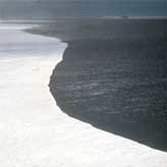Differences Between Arctic & Antarctic Sea Ice
There are several fundamental differences between Arctic and Antarctic sea ice that result from the geographic differences between the two regions.
The Antarctic sea ice zone is unbounded at its northern extent, and as a result is a highly dynamic region in which the pack ice undergoes cyclical periods of convergence and divergence under the influence of winds and ocean currents. North of the Antarctic Divergence (~65°S latitude), the pack generally moves from west to east in the Antarctic Circumpolar Current, but with a net northward component of drift. The unconstrained nature of the Antarctic pack results in a large seasonal variability in extent, and very little ice survives more than one season.
In contrast, the Arctic basin is predominantly land-locked, with only a small fraction of ice advected out of the area, mostly via Fram Strait between Greenland and Svalbard. Arctic sea ice thus exhibits less annual variability and retains a greater proportion of multiyear ice. Because of its constrained nature and greater age, Arctic sea ice attains a greater thickness than sea ice in the Antarctic, with multiyear ice being up to several metres thick (even a few tens of metres thick in ridged areas) and up to several decades old. Undeformed first-year sea ice in the Antarctic rarely reaches thicknesses greater than two metres, and only then in fast ice regions close to the coast.
Within the Antarctic pack frazil crystals which form in open water areas make a major contribution to the total ice mass, and the dynamic processes of rafting and ridging are dominant mechanisms by which the ice thickens. As sea ice in the Arctic Basin is not as mobile, fewer open water areas occur and frazil ice growth makes a smaller contribution to the total ice mass. Ice thickening due to the rafting of floes under wave action is less, although large pressure ridges are common.
Another major difference between Arctic and Antarctic sea ice is observed during the respective melt seasons. In the Arctic the sea ice begins to melt at the surface. Melt pools form and decrease the albedo of the surface, allowing more solar radiation to be absorbed and further enhancing the melt process. In the Antarctic melt occurs mainly from the bottom and sides of the ice, which are in contact with the ocean. Melt pools are rarely seen on the surface. Divergence of the pack creates more open water and as summer approaches more solar radiation is absorbed by the ocean. As the surface layer of the ocean warms up the rate of melting of the ice increases. Closer to the coast the low relative humidity of the air flowing off the Antarctic continent causes surface ablation to occur via direct sublimation of the ice to water vapour.

